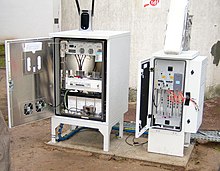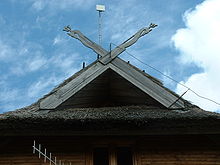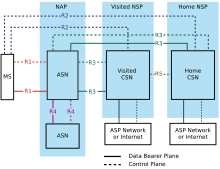WiMAX

WiMAX ( Worldwide Interoperability for Microwave Access ) is a wireless access technology to broadband internet. WiMAX is often used as a synonym for radio systems based on the IEEE standard 802.16, similar to WLAN , which is based on the IEEE standard 802.11. In fact, the name actually refers to the WiMAX forum or 802.16 systems, which meet the so-called WiMAX profile of this consortium. For a long time, the chip manufacturer Intel had great interest in the development of WiMAX .
WiMAX is high-speed transmission in the frequency range from 2 to 66 GHz. WiMAX was initially developed as a broadband radio transmission system IEEE802.16d later 802.16-2004 for stationary connections (e.g. TV tower - house antenna). In the meantime the standard has also developed into a mobile standard IEEE802.16e or 802.16e-2005 for mobile applications. According to a corresponding decision by the International Telecommunication Union , WiMAX can officially designate itself as 4G technology according to the current 802.16m standard .
The WiMAX forum is working on the further development of the standard. With IEEE802.16m (backwards compatible with 802.16e) a standard was developed that specifies high-speed transmission with up to 1 Gbit / s. Furthermore, the WiMAX forum regulates the specification of the test regulations that are necessary for the certification of the end devices and network components in order to comply with the standard.
WiMAX is currently available in over 150 countries such as the USA, Japan, Korea ( WiBro ), Taiwan, Russia, Mexico and various countries in Africa.
technical basics
The IEEE 802.16 standard belongs to the family of 802 standards , as does 802.3 Ethernet or 802.11 wireless LAN . According to the OSI model, WiMAX specifies the two lowest layers, the PHY layer (physical layer) and the MAC layer (data link layer).
Much emphasis was placed on high transmission rates with very short latency times (response times). An operating mode with guaranteed data rates has also been integrated. This Quality of Service (QoS) option is important e.g. B. for telephony and video applications, so that these are not interrupted due to insufficient data rate. In contrast to other radio technologies, preferred treatment of the voice data packets enables better voice quality. A WiMAX base station can transmit with up to 30 watt EIRP , a mobile or stationary remote station accordingly with 4 watt EIRP.
The various WiMAX / IEEE 802.16 standards
The most important are:
- IEEE 802.16-2004 also called fixed WiMAX, static connection without handover offers visual and non-visual connections, frequency range: 2–66 GHz
- IEEE 802.16e-2005, also called mobile WiMAX, allows the radio cell to be handovered during operation, frequency range: 2–6 GHz
- IEEE 802.16m high-speed transmission up to 1Gbit / s and definition of the Advanced Air Interface for gigabit transmission
There are different types of radio transmission:
WiMAX mobile
Designed for broadband access to the Internet, where the user can change the radio cell. Uses OFDMA and MIMO Multiple Input Multiple Output. MIMO technology increases the data throughput and contributes to the improvement of the signal stability in environments with reflections or without line of sight of the antennas. The WLAN standard IEEE 802.11n also uses this technology, as it is also used in other cellular radio technologies.
WiMAX fixed
Previous version of mobile WiMAX, based on OFDM . A change of the radio cell while retaining the IP address was not specified here. Where necessary, the fixed networks are converted to the mobile version today.
Further procedures for frequencies above 10 GHz
Above the frequency of 10 GHz, parabolic antennas are ideal for transmitting signals as antennas with high gain and high directional effect . The large available bandwidths of 25 GHz in the United States of America and 28 GHz in Europe enable very high data transmission rates. A prerequisite for this, however, is a line of sight (LoS) between the two antennas . The method described is therefore suitable for connection over long distances, e.g. B. as a backbone or to connect base stations via radio link.
practice
WiMAX is now used both as a stationary (fixed WiMAX) and as a radio technology for mobile Internet with high data rates in cellular networks. The coverage radius of a base station in an urban environment is usually between 2 and 5 kilometers. As with all mobile radio systems, the users involved have to share the available data rate. For mobile WiMAX according to 802.16e-2005, a data rate of ~ 40 Mbit / s is currently specified here.
In the WiMAX forum , over 430 technology companies and institutions have come together to ensure compatibility with the products of various manufacturers by standardizing WiMAX. To date, more than 196 different receiving devices such as cell phones, notebooks, USB sticks, tablets and WiMAX home modems have been certified.
Distribution of WiMAX (geographical)
Development in Germany
From 2005, the German broadband services GmbH (DBD) offered commercial WiMAX offers. The company used WLL licenses in the 3.5 GHz band to use technology based on the Fixed WiMAX standard certified in 2005.
The Federal Network Agency awarded the WiMAX licenses as broadband wireless access licenses (BWA licenses) for frequencies from 3400 to 3600 MHz in an auction at the end of 2006. Five of the six interested parties acquired licenses for around 56 million euros.
Nationwide licenses were bought by the US company Clearwire, German broadband services GmbH (DBD), which made offers under the name MAXXonair in cities and under DSLonair in rural areas, and Inquam, a joint venture of the WiMAX developer NextWave Wireless with financial investors and Omnia Holdings Limited. The Italian MGM Productions Group SRL and Televersa bought regional licenses for Bavaria online. The latter returned the license and offers broadband internet access regionally in Eastern Bavaria - using WLL technology.
WIMAX offers did not prevail over DSL and LTE providers in Europe. At the end of 2012, the DBD ended the supply in Berlin and Dresden.
Europe
In Europe, further WiMAX networks are already available in Ireland (operated by Imagine Communication Group), Spain (operated by Iberbanda) or Portugal (operated by the company ZAPP.PT).
Austria, Croatia, Slovakia
The Austrian WiMAX Telecom consortium set up networks in Croatia and Slovakia . In 2009, WiMAX Telecom went bankrupt. Another provider in Croatia is Optima Telekom .
The Croatian network agency issued WiMAX licenses in 11 counties .
| company | Licenses |
|---|---|
| Dubrovnik Telecom | 1 |
| Globalnet | 1 |
| H1 Telecom (Portus) | 5 |
| Novi-net | 1 |
| Odašiljači i veze (OiV) | 11 |
| Optima Telecom | 10 |
| T-Hrvatski Telekom (T-Com, Iskon) | 6th |
| Vipnet | 1 |
| Wimax Telecom | 8th |
The company Odašiljači i veze (OiV), which also manages the transmission systems of the national television and radio stations, emerged as the winner.
Lithuania
In Lithuania , WiMAX has been offered since summer 2004 mainly for areas where there are no telephone lines. The prices are around € 30 for a 64 kbit / s flat rate with a fixed IP address.
Bulgaria
Four WiMAX licenses were auctioned in Bulgaria in summer 2005. Commercial operation began in February 2007 with the first Mobiltel network in around 10 larger cities with tariffs exclusively for business customers at prices equivalent to around 30 euros per month for a flat rate with symmetrical bandwidth and a data rate of 1 Mbit / s. In 2010, Mobiltel sold its license to Max Telecom, the second operator, Trans Telecom, filed for bankruptcy at the end of 2010 and lost its license in April 2011. The third operator, Nexcom, continues to offer its services to business customers, only Max Telecom continues to expand its network and offer tariffs also to private customers with two tariffs for the equivalent of 10 euros per month and bandwidths of 8 and 16 Mbit / s. The market has around 20,000 customers.
Russia
In Moscow and St. Petersburg since November 2008, in Ufa, Krasnodar, Vyborg and Sochi since mid-2009, the mobile WiMAX according to IEEE 802.16e-2005 WiBro from the provider Yota has been available nationwide. As of March 2011, the service costs 1400 rubles, or about 35 euros per month. The effective data rate is 5 Mbit / s.
Africa
South Africa
WiMAX technology has been widespread in South Africa under the name iBurst for several years and is enjoying increasing popularity. iBurst is widespread in most cities in South Africa and is currently the cheapest way to connect to the Internet . Various data volume packages from around 15 euros per month are available. The download stream is up to 1024 Kbps.
Sierra Leone and Mozambique
Due to the poor fixed network supply in Sierra Leone and Mozambique , the Multinet Group is building a WiMAX network from 2008 . The Internet is expected to break through in both countries.
United States
In the USA, the largest WiMAX network to date based on the IEEE802.16e is online and operated by Clearwire. The network already reaches more than 119 million people in more than 70 cities. After Sprint took over Clearwire in 2013, it was decided to discontinue WiMAX operations by the end of 2015.
Asia
In Japan a WiMAX network is operated by UQ Communication. More than 800,000 users are expected here by March 2011. In Korea, KT Telecom operates a network with nationwide coverage. Both companies signed a roaming agreement in early 2011. This means that users can use both networks. Further networks can be found in Malaysia, Laos, Taiwan and also India.
WiMAX plays a special role in Taiwan: According to analysts and industry experts, sales of the equivalent of 100 million US dollars are expected. With LTE cellular technology, sales of almost one billion US dollars are expected for the Taiwanese market.
Future of WiMAX
WiMAX-compatible cell phones from HTC and Samsung were available for a short time. Other phones and tablets from various manufacturers such as Blackberry , Motorola and HTC were announced for 2011, but were no longer published. USB modems and CPEs are available.
The long-term evolution standard has largely established itself in the mobile communications sector. The wireless technology has evolved over the years and has become the key technology par excellence for public access points ( hot spots ). Especially in emerging countries, WLAN is enjoying increasing popularity due to the generally available hardware and high compatibility of devices from different manufacturers with one another. The disadvantage of WLAN compared to cellular communications is still the much shorter range.
In April 2014 it was announced that the largest WiMAX network in the USA will be shut down by its operator Sprint in favor of LTE technology by the end of 2015. Sprint took over the network from Clearwire in 2013 . It last had around 17,000 broadcasting stations.
In May 2014, a majority of the active members in the IEEE 802.11 working group voted to dissolve the corresponding IEEE 802.16 working group. The reason given is the lack of market success of the WiMAX standard IEEE 802.16.
See also
- Broadband wireless access
- Radio network
- Max-fi
- WiMAX forum
- Wireless Local Loop (WLL)
- Wireless Metropolitan Area Network (WMAN)
literature
- K. Fazel and S. Kaiser: Multi-Carrier and Spread Spectrum Systems: From OFDM and MC-CDMA to LTE and WiMAX . 2nd Edition. John Wiley & Sons, 2008, ISBN 978-0-470-99821-2 .
- Max Riegel, Aik Chindapol, Dirk Kroeselberg: Deploying Mobile WiMAX . John Wiley & Sons, 2009, ISBN 978-0-470-69476-3 .
Web links
- heise mobil: Competitive waves ( Memento from December 16, 2005 in the Internet Archive )
- IEEE 802.16 / WiMAX. In: Elektronik-Kompendium.de
- IEEE 802.16
- Database of certified WiMAX devices
- Wolfgang Schulte: IP data traffic via Wimax - standard with advantages, but an uncertain future. DHBW Stuttgart , in: NET 10/10 p. 37 (PDF; 415 kB)
- LTE ("Long Term Evolution") is replacing WiMAX in India
- IEEE conference: even more steam for 60 GHz WLAN (section: Wimax goodbye)
- Largest WiMAX network in the USA is shut down
Individual evidence
- ↑ Richard Sietmann: Analog Legacy. In: c't 11/2009, p. 176
- ↑ https://www.teltarif.de/i/wimax-historie.html Kai Petzke / Marie-Anne Winter / Susanne Kirchhoff: WiMAX: Everything about frequencies and network expansion
- ↑ http://computer-oiger.de/2012/12/03/zuviel-konferenz-dbd-schaltet-teile-des-dresdner-wimax-netz-ab
- ↑ https://www.heise.de/newsticker/meldung/Oesterreichische-Wimax-Telecom-ist-pleite-846613.html
- ↑ - ( Memento of the original from March 2, 2000 in the Internet Archive ) Info: The archive link was inserted automatically and has not yet been checked. Please check the original and archive link according to the instructions and then remove this notice.
- ↑ http://www.oiv.hr/
- ↑ Archived copy ( Memento of the original from April 17, 2006 in the Internet Archive ) Info: The archive link was inserted automatically and has not yet been checked. Please check the original and archive link according to the instructions and then remove this notice. iBurst in South Africa
- ↑ Multinet website
- ↑ a b Largest WiMAX network in the USA is shut down. In: heise.de , April 9, 2014.
- ↑ Taiwan will benefit from the mobile Long Term Evolution. ( Memento from November 7, 2011 in the Internet Archive ) In: lte-discounter.de
- ↑ Google is planning WLAN airships for Africa and Asia. In: derstandard.at , May 21, 2014.
- ↑ Annual Report 2013 - filed with the US Securities and Exchange Commission
- ↑ IEEE conference: Even more steam for 60 GHz WLAN. In: heise.de , May 21, 2014.

